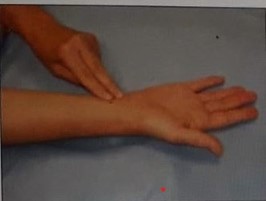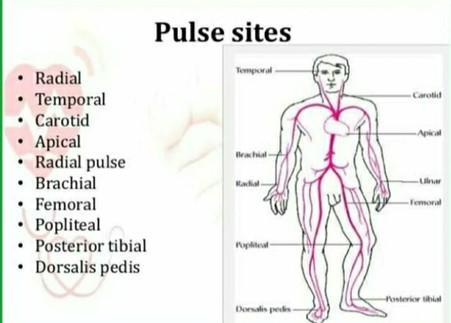The practical nurse (PN) observes a newly hired unlicensed assistive personnel (UAP) who is counting a client's radial pulse as seen in the picture. Which action should the PN take?

Instruct the UAP to report any abnormal findings.
Remind the UAP to check the client's pulse volume.
Demonstrate the correct pulse site to the UAP.
Confirm the accuracy of the pulse rate obtained by the UAP.
The Correct Answer is C
- A radial pulse is the pulse felt at the wrist, where the radial artery runs along the thumb side of the forearm. It is one of the most common sites for measuring a person's heart rate.
- To measure a radial pulse, the examiner should place two or three fingers over the radial artery, just below the wrist crease, and apply gentle pressure until a pulsation is felt. The examiner should not use the thumb, as it has its own pulse and may interfere with the accuracy of the measurement. The examiner should count the number of beats for 15, 30, or 60 seconds, depending on the regularity and rate of the pulse.
- In the picture, the unlicensed assistive personnel (UAP) is using the thumb to measure the radial pulse, which is incorrect. The practical nurse (PN) should demonstrate the correct pulse site to the UAP and explain why using the thumb is not appropriate. This will help to ensure that the UAP obtains an accurate and reliable pulse rate for the client.
Therefore, option C is the correct answer, while options A, B, and D are incorrect.
Option A is incorrect because instructing the UAP to report any abnormal findings does not address the error in technique.
Option B is incorrect because reminding the UAP to check the pulse volume does not address the error in technique.
Option D is incorrect because confirming the accuracy of the pulse rate obtained by the UAP does not address the error in the technique.

Nursing Test Bank
Naxlex Comprehensive Predictor Exams
Related Questions
Correct Answer is A
Explanation
A) Correct - Acute dystonic reactions are involuntary muscle spasms caused by certain medications, including antipsychotic drugs. These reactions can sometimes affect the muscles of the face and neck, including the larynx. Benztropine is an anticholinergic medication commonly used to treat acute dystonic reactions. It works by blocking certain neurotransmitters that contribute to muscle spasms, helping to relieve the symptoms.
B) Incorrect - Divalproex is an anticonvulsant medication primarily used to treat epilepsy and bipolar disorder. It is not the appropriate treatment for acute dystonic reactions. These reactions are usually caused by certain antipsychotic medications and are characterized by sudden and involuntary muscle contractions. Divalproex does not have the specific mechanism of action needed to alleviate the symptoms of acute dystonic reactions.
C) Incorrect - Isotonic crystalloid fluids are used for various purposes, such as fluid resuscitation, maintaining hydration, and balancing electrolytes. However, they are not a treatment for acute dystonic reactions. These reactions are neurological and musculoskeletal in nature and require medications with specific anticholinergic properties, like benztropine, to address the underlying issue.
D) Incorrect - Lorazepam is a benzodiazepine commonly used for anxiety, sedation, and seizure control. While it can have a relaxing effect on muscles, it is not the first-line treatment for acute dystonic reactions. Anticholinergic medications like benztropine are more appropriate because they directly counteract the neurotransmitter imbalances that lead to muscle spasms in these reactions.
Correct Answer is ["A","B","D","E"]
Explanation
A) Correct - Demonstrating the technique used to monitor blood glucose levels is crucial.
Incorrect technique can lead to inaccurate readings, impacting insulin dosing decisions and blood sugar control.
B) Correct - Some asthma medications, like corticosteroids, can elevate blood glucose levels.
Evaluating the client's asthma medications is essential as they can contribute to fluctuations in blood sugar levels.
C) Incorrect- Asking the client if they want a different manufacturer's glucose monitoring device is not helpful, because it does not address the underlying causes of the poor glycemic control. The client may also perceive this as a lack of confidence in their ability to manage their diabetes or as a criticism of their choice of device. The nurse should focus on educating the client on how to use their current device correctly and consistently, rather than suggesting a change that may not be necessary or feasible.
D) Correct - Understanding the client's daily routine helps identify factors influencing blood glucose control, such as meal timing, activity level, and stress. This information aids in creating a personalized diabetes management plan.
E) Correct - Ensuring the client uses a new insulin needle for each administration is important for preventing infection and complications. Reusing needles can affect injection site health and insulin absorption.
Whether you are a student looking to ace your exams or a practicing nurse seeking to enhance your expertise , our nursing education contents will empower you with the confidence and competence to make a difference in the lives of patients and become a respected leader in the healthcare field.
Visit Naxlex, invest in your future and unlock endless possibilities with our unparalleled nursing education contents today
Report Wrong Answer on the Current Question
Do you disagree with the answer? If yes, what is your expected answer? Explain.
Kindly be descriptive with the issue you are facing.
